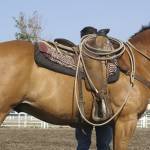Trail Riding Safety: Avoid an Assault on Yourself and Your Horse

“Just because an area is familiar doesn’t mean it’s safe.” These words of wisdom from a police officer apply just as much to trail riding as they do to taking a stroll around your own neighborhood. You may have safely ridden a familiar trail many times; that doesn’t mean you can’t run into trouble on your next visit.
No one wants to think about being attacked while on horseback, but in reality, remote trails are perfect places for crimes to occur. Follow these tips to avoid becoming the victim of an assault or robbery while you’re out on the trail.
- Basic trail safety involves not riding alone; carrying a cell phone; checking your tack and other equipment before you start the ride; and being familiar with maps, signs, and trail markers so that you know where you are.
- Pay attention to your surroundings. If you are daydreaming, wearing headphones, or carrying on a loud nonstop conversation with your companions, you probably aren’t watching or listening for signs of possible danger.
- Look around and behind yourself frequently, not just to check for threatening people but to identify avenues of escape in case of an attack.
- Never let anyone approach closely enough to touch or pat your horse. You are under no obligation to be polite; your first priority is the safety of yourself and your horse. Ask people, even nonthreatening ones, to keep their distance. Tell them that the horse likes to bite! Move your horse away if someone continues to approach.
- If someone refuses to back away, making you feel threatened, drive your horse into the person if you can’t ride away. Before you go trail riding, train your horse to move off your leg. Side-passing or swinging the horse’s haunches into a person are safer maneuvers than a head-first move because you don’t want the attacker to grab the horse’s bridle. However, most people will try to avoid being run over, so a head-first move may throw the attacker off balance before he can touch the horse.
- Pepper spray is an effective deterrent, but there are some cautions related to its use. Pepper spray may not be legal in your area, so check with authorities before carrying it (put the canister in an easy-to-reach holster rather than buried in a saddlebag). Various forms of spray canisters are available; you want one that can be aimed and sprayed at a distance. Most important: your horse may jump or shy because of the sound, so either desensitize him to a similar noise before you need to use the spray, or grab some mane and be ready for him to jump.
- Remember, your first objective is to get away, not to fight or subdue the attacker. Your horse’s size and speed are important assets. If you do end up having to fight off an attacker, some methods will be safer and more effective than others. Consider having a police officer work with your riding club to teach you the best way to combat someone who is bothering you on the trail.








